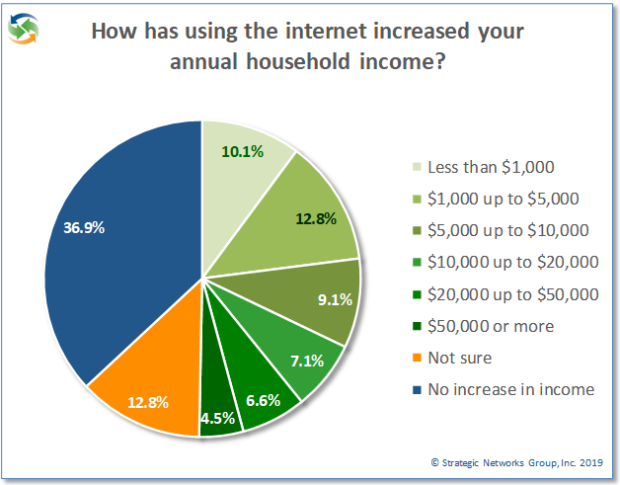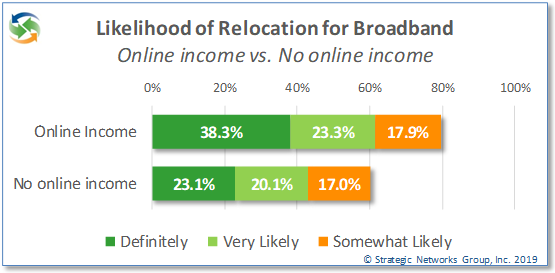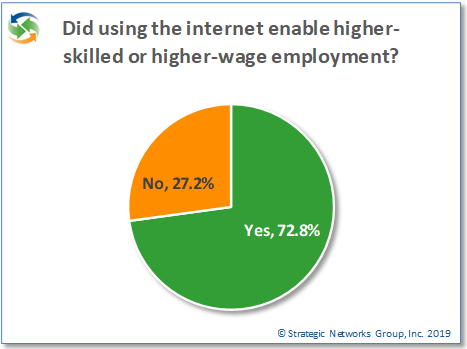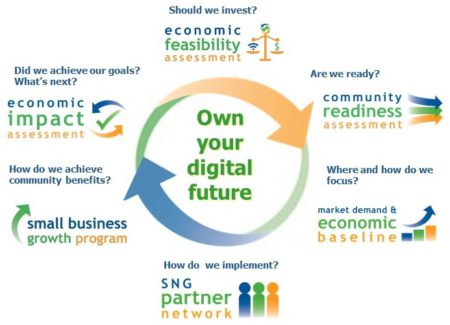 SNG Research Brief – Broadband Impact on Household Income
SNG Research Brief – Broadband Impact on Household Income
Household uses of the internet are often seen as lifestyle enhancements or conveniences, such as online entertainment, social networking, paying bills, or simply browsing for information on topics of inetrest. However, a significant number of households also use the internet to generate income, ranging from small amounts of supplementary income to full time home business income.
More than entertainment and social apps
 SNG’s research of more than 18,000 households shows that 89% have a personal web presence and, while the majority use this for personal or professional networking, more than 30% of these households use their web presence to generate income. Overall, more than 50% of households report that the use of broadband has enabled them to increase their household income in one way or another. 29% earn substantial supplementary income of between $1,000 and $20,000 annually, while another 12% earn more than $20,000 annually. At whatever level of additional income, it can make a huge difference to the lifestyle of most people, and households are finding ways to use the internet and their broadband connections to make it happen.
SNG’s research of more than 18,000 households shows that 89% have a personal web presence and, while the majority use this for personal or professional networking, more than 30% of these households use their web presence to generate income. Overall, more than 50% of households report that the use of broadband has enabled them to increase their household income in one way or another. 29% earn substantial supplementary income of between $1,000 and $20,000 annually, while another 12% earn more than $20,000 annually. At whatever level of additional income, it can make a huge difference to the lifestyle of most people, and households are finding ways to use the internet and their broadband connections to make it happen.
The two most obvious ways that the internet and broadband connections can be used to generate household income are teleworking and home-based businesses. These create income directly from employment and from business activities respectively. However, even excluding these households more than 41% of the remainder still generate additional household income online in amounts large and small.
It is no surprise, then, that more than 50% of households see the ability to work from home as a significant benefit of broadband, and 37% say that the opportunity to earn additional income is a very significant benefit. While there are many other lifestyle benefits from broadband that rate higher across all households, one should not underestimate the significance and impact of how many households use broadband to create household income.
 When you have income generation, access to the internet with quality broadband becomes much more than a “nice to have”. Households see the value in this and community leaders need to recognize this as well. In fact, the likelihood of relocating for quality broadband is significantly higher for those generating income online compared to households that do not. These are innovative households that communities can ill-afford to lose.
When you have income generation, access to the internet with quality broadband becomes much more than a “nice to have”. Households see the value in this and community leaders need to recognize this as well. In fact, the likelihood of relocating for quality broadband is significantly higher for those generating income online compared to households that do not. These are innovative households that communities can ill-afford to lose.
Broadband enhances the workforce
While earning additional household income is significant, the majority of working households still have one or more members employed at jobs, either at an employer establishment or by teleworking. Having access to quality broadband helps households improve their employment in two important ways. First, broadband provides access to online training and education for enhancing skills and learning new ones. Second, with access to a world of opportunities the internet helps people find better jobs, including the ability to telework rather than relocate.
 More than 45% of households use the internet for education or training courses. Of these, 45% strongly agree that online education provides access to more learning opportunities and more than 30% say that online training enabled the completion of a degree or certification. It is significant that broadband can make such a potential difference to the livelihood of one in seven households.
More than 45% of households use the internet for education or training courses. Of these, 45% strongly agree that online education provides access to more learning opportunities and more than 30% say that online training enabled the completion of a degree or certification. It is significant that broadband can make such a potential difference to the livelihood of one in seven households.
Of those households that had a member finding new employment, 73% said that using the internet helped them to gain better employment in higher-skill or higher-wage jobs, with 20% of those households using telework.
Broadband enables people to enhance their skills wherever they live and to find better employment while remaining in their community. These benefits of broadband do not impact every household since not everyone is equally motivated to follow these paths, but broadband makes it possible for those who do.
See what broadband means for a rural county and how they got the support and funding to build the digital infrastructure they need to thrive – Custer County Broadband Impact and Market Assessment.

Find out more about SNG Solutions for Local Economic Development.

Digital Economy Industry Insights Barometer Gives Businesses Better Understanding of Online Activities that Impact Their Bottom Line
 Strategic Networks Group rolled out a new tool for small businesses to assess their digital effectiveness at America’s SBDC 35th Anniversary Annual Conference in San Francisco, earlier this month. The Digital Economy Industry Insights Barometer will be available on America’s SBDC ( www.americassbdc.org) and at sngroup.com/barometer.
Strategic Networks Group rolled out a new tool for small businesses to assess their digital effectiveness at America’s SBDC 35th Anniversary Annual Conference in San Francisco, earlier this month. The Digital Economy Industry Insights Barometer will be available on America’s SBDC ( www.americassbdc.org) and at sngroup.com/barometer.
Starting today, SBDC’s business clients can take a two-minute survey to uncover how the most common Internet applications and platforms financially impact their bottom line. The potential revenues and cost savings are based on SNG’s proprietary database of impacts reported by nearly 40,000 businesses from across the United States. Results are reported based on company size and industry to ensure relevance and businesses are provided a basic utilization score to help then gauge where they stand against their industry average.
“Intuitively, building out broadband networks across America will afford small businesses an advantage in growing and sustaining their businesses. However, providing SBDC small business clients with actual ROI numbers for Internet applications empowers them to make decisions regarding the online business activities that will impact their businesses the most,” explained Donna Ettenson, VP of Operations at America’s SBDC
“We’re looking to help businesses understand the financial impacts they can realize online no matter their size or industry,” said Michael Curri, president and founder of SNG. “America’s SBDC’s stand at the intersection of Internet and small businesses and have a unique opportunity to help drive real economic impact through these yet-to-be-adopted applications.”
About Strategic Networks Group (SNG)
Focused on economic advancement through broadband utilization, SNG is a group of broadband economists who develop strategies for most effectively leveraging broadband investments. SNG addresses broadband utilization from the individual organization level all the way up to working with more than ten American states. SNG looks to help make the most broad-reaching and transformational impacts that broadband can bring to enable businesses, communities and regions by delivering the data and analysis decision makers need to maximize broadband’s potential. Learn more about SNG online at www.sngroup.com

As we focus on how we can make our broadband initiatives successful and network builds sustainable, have you ever been asked by your constituents – how do we compare? What are other communities doing to fully leverage broadband? What are the benefits of broadband that my business should be leveraging? How can my household better access health, educational, and civic services? In general, how am I doing?
SNG has developed a Digital Economy Index (DEi) – which scores how businesses, organizations, and households use key online practices. The DEi enables benchmarking of seventeen (17) key online practices for businesses and organizations and thirty (30) key online practices for households.
To personalize the value of broadband and online practices to individual businesses (especially small businesses that often do not have information technology directors), SNG has developed a DEi Scorecard that draws on industry leading metrics from our Digital Economy Database to assist small businesses and other organizations see where they stand. SNG’s DEi is a composite score of how organizations use online practices, or “e-solutions,” to drive productivity and competitiveness. By providing organizations’ with their DEi score, you are providing them insights into their competitiveness and relevance in an online economy by showing them how they compare to their peers and where they can adjust to increase efficiencies, innovation, and profitability.
The Digital Economy Index helps organizations develop their own broadband adoption plan (and economic growth path). Which leads into the next step, awareness & adoption support (Step 5 of the Broadband Lifecycle, or path to owning your digital future).

By Michael Curri – Broadband networks can create a “platform for productivity, competitiveness and innovation” in your community – delivering the infrastructure to capture economic and social opportunities, some known, some yet to be invented. Many communities fail during the broadband strategy, build-out and adoption phases as they lack focus and/or sufficient investment of time, energy, and resources.
Too often communities develop strategies based on following recipes from other regions. Instead of uncovering what the needed resources are, or how to leverage current efforts to best serve the specific and unique needs of the community, civic leaders race to “do what they did.”
There is no ‘one size fits all’ solution for successful broadband strategies that bring economic and civic benefits to a region and its citizens. Each community not only has different needs, but different strengths to best leverage the broadband platform. Strategic Networks Group (SNG) has for years been helping governments, at municipal, regional and national levels, to best understand where investment will make the biggest impact – and each and every time the best approach involves following the Broadband Lifecycle, or path to owning your digital future.
Continue Reading →
By Doug Adams
Now that you have funding, how can you make sure that your project lives up to the promise that got it funded in the  first place? Hundreds of broadband projects are being funded in 2010 – be it from Stimulus or some other funding source – but how many will truly become a community asset that drives economic and social benefits?
first place? Hundreds of broadband projects are being funded in 2010 – be it from Stimulus or some other funding source – but how many will truly become a community asset that drives economic and social benefits?
Key to making sure your project will have a return on investment with quantifiable outcomes starts with these four guidelines:
- Don’t focus on engineering: it’s all about awareness and adoption;
- Use data to drive decisions before, during, and after the project;
- Create a “platform for innovation”: investing in broadband is NOT just about the financials;
- Frame the benefits, measure them, and promote.
Continue Reading →
 (Read the entire article by Gary Dunmore here)
(Read the entire article by Gary Dunmore here)
Today, most people and businesses are computer literate, and aware of the Internet’s potential – at least in general terms: about 70% of households have a computer at home with some form of Internet access (increasingly broadband), many others have access to computers and the Internet at other locations (such as the workplace or school) and virtually every business uses computers and over 85% have Internet access. Many households and businesses don’t “use” broadband mostly because it is not available in their area. However that’s changing fast – as private and public investments help make broadband increasingly more available and adoption more straightforward. The proof: current research shows that US household broadband adoption increased from 55% to 63% in the past year, while dial-up Internet use dropped from 10% to 7% over the same period.
But this also means that up to 30% of households remain “unconnected” to the Internet – for a variety of reasons, including uncertain relevance, affordability, and availability. And, while connected to a greater degree, many small businesses face the same issues when it comes to broadband adoption.
What it is missing?
For many, it is a complicated matter: firstly understanding what broadband can do for them, and then understanding that it is worth doing, and finally understanding how to make it happen. Increasing the understanding of broadband relevance contributes to the adoption of broadband by new users and increases the “benefits” of broadband by those that have it.
Continue Reading →
 SNG Research Brief – Broadband Impact on Household Income
SNG Research Brief – Broadband Impact on Household Income SNG’s research of more than 18,000 households shows that 89% have a personal web presence and, while the majority use this for personal or professional networking, more than 30% of these households use their web presence to generate income. Overall, more than 50% of households report that the use of broadband has enabled them to increase their household income in one way or another. 29% earn substantial supplementary income of between $1,000 and $20,000 annually, while another 12% earn more than $20,000 annually. At whatever level of additional income, it can make a huge difference to the lifestyle of most people, and households are finding ways to use the internet and their broadband connections to make it happen.
SNG’s research of more than 18,000 households shows that 89% have a personal web presence and, while the majority use this for personal or professional networking, more than 30% of these households use their web presence to generate income. Overall, more than 50% of households report that the use of broadband has enabled them to increase their household income in one way or another. 29% earn substantial supplementary income of between $1,000 and $20,000 annually, while another 12% earn more than $20,000 annually. At whatever level of additional income, it can make a huge difference to the lifestyle of most people, and households are finding ways to use the internet and their broadband connections to make it happen. When you have income generation, access to the internet with quality broadband becomes much more than a “nice to have”. Households see the value in this and community leaders need to recognize this as well. In fact, the likelihood of relocating for quality broadband is significantly higher for those generating income online compared to households that do not. These are innovative households that communities can ill-afford to lose.
When you have income generation, access to the internet with quality broadband becomes much more than a “nice to have”. Households see the value in this and community leaders need to recognize this as well. In fact, the likelihood of relocating for quality broadband is significantly higher for those generating income online compared to households that do not. These are innovative households that communities can ill-afford to lose. More than 45% of households use the internet for education or training courses. Of these, 45% strongly agree that online education provides access to more learning opportunities and more than 30% say that online training enabled the completion of a degree or certification. It is significant that broadband can make such a potential difference to the livelihood of one in seven households.
More than 45% of households use the internet for education or training courses. Of these, 45% strongly agree that online education provides access to more learning opportunities and more than 30% say that online training enabled the completion of a degree or certification. It is significant that broadband can make such a potential difference to the livelihood of one in seven households.


 Strategic Networks Group rolled out a new tool for small businesses to assess their digital effectiveness at America’s SBDC 35th Anniversary Annual Conference in San Francisco, earlier this month. The Digital Economy Industry Insights Barometer will be available on America’s SBDC (
Strategic Networks Group rolled out a new tool for small businesses to assess their digital effectiveness at America’s SBDC 35th Anniversary Annual Conference in San Francisco, earlier this month. The Digital Economy Industry Insights Barometer will be available on America’s SBDC ( 
 (Read the
(Read the 

